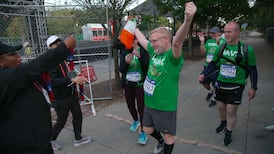Shortly before he spent seven and a half rounds torturing Canada's David Lemieux at Madison Square Garden last Saturday night, Gennady Golovkin was visited in his dressing-room by Donald Trump. When the big screen hanging over the arena flashed up the image of the gurning presidential candidate yukking it up with the middleweight champion of the world, 20,000 people booed lustily.
The irony of a xenophobe whose anti-immigration stance has been a cornerstone of his campaign doing a photo opportunity with a Kazakh fighting out of Los Angeles wasn’t lost on a crowd where many wore t-shirts that read “Mexicans for Golovkin”.
Trump, like the other celebrities necklacing the ring in what felt like a throwback to the Garden’s 1980s’ heyday, sought some glamour by association with the most exciting fighter on the planet.
By the end of the evening, Golovkin had confirmed that status once again, delivering yet another “Big Drama Show”, his broken English having spawned his very own catchphrase.
He also speaks Kazakh, Russian and Korean but, really, his performances require no translation. With an unbeaten record of 34-0, this was his 21st successive stoppage and 15th successful defence of his title, each one hallmarked by wince-inducing, percussive power that has earned him the title “the most avoided boxer of his generation”.
Recent retirement
Nobody may want to fight him (and even a cursory glimpse at the Vines or the still photos of the punishment he inflicted on Lemieux may explain why) but with the recent retirement of Floyd Mayweather Junior, boxing has anointed Golovkin as the heir apparent. That he is the anti-Mayweather, far more thrilling inside the ring, more humble and self-effacing outside it, makes him ideal for the role.
Perhaps the most gaudy thing about him is the Triple G (Gennady Gennadyevich Golovkin) nickname. Everything else is refreshingly downhome and charming, a winning persona attracting casual fans the same way Mayweather’s obnoxiousness eventually repelled them.
That boxing’s immediate future appears wrapped up in a pay-per-view debutant who turns 34 this coming April, and hails from a country most Americans probably presume is the fictitious homeland of Sacha Baron Cohen’s Borat, sums up the rather strange condition of the contemporary fight game. For selling out the Garden, Golovkin drew down $2 million and a share of the television money. Relatively paltry sums compared to what Mayweather has been banking for years, these less than impressive numbers are, in some ways, an unfortunate consequence of his own success.
“Golovkin is a beast,” said veteran promoter Lou DiBella after watching him knock out Matthew Macklin two years back. “He’s an animal. This kid is going to demolish people for a while. In terms of ability, he is an absolute animal.”
The more his reputation for bringing contests to premature and violent conclusions grew, the more difficult it became to schedule bouts against genuine contenders – a proposed Andy Lee fight was postponed in 2014 because of the death of Golovkin's father. Although Lemieux, with an impressive record of 34 wins (31 by knock-out) and three losses, was marketed at the box office as a credible threat to Golokvin, the cognoscenti believe he was actually hand-picked for his staying power.
The promoters wanted and got somebody with the guts to stay upright long enough so Golovkin could showcase the full panoply of his destructive abilities on the biggest stage.
He landed nearly 300 punches (more than half of them power shots) before the referee stepped in and, in the days since, the American media has cottoned on to Golovkin’s fascinating backstory.
Born in Karaganda (somebody recently compared it to the worst neighbourhood in Detroit) when Kazakhstan was still part of the old Soviet Union, two of his older brothers were killed while serving in the Red Army. His father was a coal-miner, and his mother Elizabeth, a technician at a chemical lab, was the granddaughter of an immigrant from Korea.
For Golovkin and his twin brother Max, boxing represented a potential way out.
Their amateur careers ran along parallel paths until the 2004 Olympic trials when Max withdrew rather than face his sibling. In Athens, Golokvin took the silver medal and started to pop up on the radar of professional trainers. When the judges robbed him of a certain victory against Egypt’s Mohamed Hikal at the next year’s World Championships, he signed on with Universum, a German promoter where, after steady initial progress a a pro, his trajectory plateaued and he had to sue his way out of the deal.
His corner
In 2011, Golovkin flew to Big Bear Mountain, California to meet
Abel Sanchez
, the trainer who has been in his corner ever since.
“Ray Charles could train him,” said Sanchez recently, downplaying the crucial part he has played in transforming Golovkin from an unknown Eastern European boxer into somebody now fronting an Apple Watch commercial and reportedly negotiating a deal with Nike.
These lucrative commercial endorsements will be a fraction of his earning power if – and it’s a pretty big if – the best middleweights now prove willing to get in the ring with him. Already, there is talk of somewhere like 100,000-seater Cowboys’ Stadium in Texas hosting a potential super-fight against the winner of next month’s WBC title clash between Miguel Cotto and Canelo Alvarez. Andy Lee may also come back into the picture if he sees off BillyJoe Saunders.
Wherever, whenever, whoever, the only thing we know for sure is it will be another “big drama show”.













